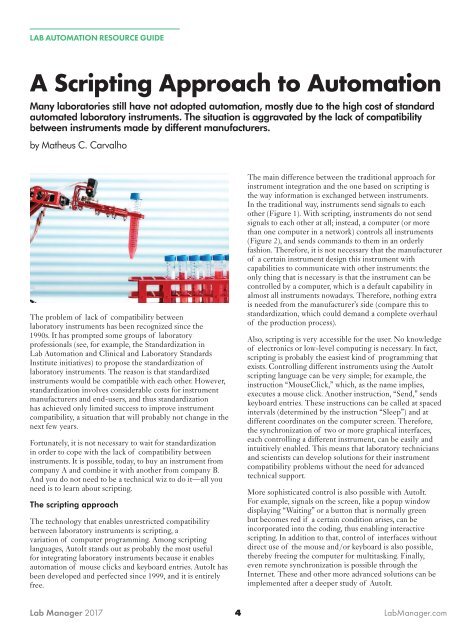Lab Automation
You also want an ePaper? Increase the reach of your titles
YUMPU automatically turns print PDFs into web optimized ePapers that Google loves.
LAB AUTOMATION RESOURCE GUIDE<br />
A Scripting Approach to <strong>Automation</strong><br />
Many laboratories still have not adopted automation, mostly due to the high cost of standard<br />
automated laboratory instruments. The situation is aggravated by the lack of compatibility<br />
between instruments made by different manufacturers.<br />
by Matheus C. Carvalho<br />
The problem of lack of compatibility between<br />
laboratory instruments has been recognized since the<br />
1990s. It has prompted some groups of laboratory<br />
professionals (see, for example, the Standardization in<br />
<strong>Lab</strong> <strong>Automation</strong> and Clinical and <strong>Lab</strong>oratory Standards<br />
Institute initiatives) to propose the standardization of<br />
laboratory instruments. The reason is that standardized<br />
instruments would be compatible with each other. However,<br />
standardization involves considerable costs for instrument<br />
manufacturers and end-users, and thus standardization<br />
has achieved only limited success to improve instrument<br />
compatibility, a situation that will probably not change in the<br />
next few years.<br />
Fortunately, it is not necessary to wait for standardization<br />
in order to cope with the lack of compatibility between<br />
instruments. It is possible, today, to buy an instrument from<br />
company A and combine it with another from company B.<br />
And you do not need to be a technical wiz to do it—all you<br />
need is to learn about scripting.<br />
The scripting approach<br />
The technology that enables unrestricted compatibility<br />
between laboratory instruments is scripting, a<br />
variation of computer programming. Among scripting<br />
languages, AutoIt stands out as probably the most useful<br />
for integrating laboratory instruments because it enables<br />
automation of mouse clicks and keyboard entries. AutoIt has<br />
been developed and perfected since 1999, and it is entirely<br />
free.<br />
The main difference between the traditional approach for<br />
instrument integration and the one based on scripting is<br />
the way information is exchanged between instruments.<br />
In the traditional way, instruments send signals to each<br />
other (Figure 1). With scripting, instruments do not send<br />
signals to each other at all; instead, a computer (or more<br />
than one computer in a network) controls all instruments<br />
(Figure 2), and sends commands to them in an orderly<br />
fashion. Therefore, it is not necessary that the manufacturer<br />
of a certain instrument design this instrument with<br />
capabilities to communicate with other instruments: the<br />
only thing that is necessary is that the instrument can be<br />
controlled by a computer, which is a default capability in<br />
almost all instruments nowadays. Therefore, nothing extra<br />
is needed from the manufacturer’s side (compare this to<br />
standardization, which could demand a complete overhaul<br />
of the production process).<br />
Also, scripting is very accessible for the user. No knowledge<br />
of electronics or low-level computing is necessary. In fact,<br />
scripting is probably the easiest kind of programming that<br />
exists. Controlling different instruments using the AutoIt<br />
scripting language can be very simple; for example, the<br />
instruction “MouseClick,” which, as the name implies,<br />
executes a mouse click. Another instruction, “Send,” sends<br />
keyboard entries. These instructions can be called at spaced<br />
intervals (determined by the instruction “Sleep”) and at<br />
different coordinates on the computer screen. Therefore,<br />
the synchronization of two or more graphical interfaces,<br />
each controlling a different instrument, can be easily and<br />
intuitively enabled. This means that laboratory technicians<br />
and scientists can develop solutions for their instrument<br />
compatibility problems without the need for advanced<br />
technical support.<br />
More sophisticated control is also possible with AutoIt.<br />
For example, signals on the screen, like a popup window<br />
displaying “Waiting” or a button that is normally green<br />
but becomes red if a certain condition arises, can be<br />
incorporated into the coding, thus enabling interactive<br />
scripting. In addition to that, control of interfaces without<br />
direct use of the mouse and/or keyboard is also possible,<br />
thereby freeing the computer for multitasking. Finally,<br />
even remote synchronization is possible through the<br />
Internet. These and other more advanced solutions can be<br />
implemented after a deeper study of AutoIt.<br />
<strong>Lab</strong> Manager 2017<br />
4<br />
<strong>Lab</strong>Manager.com


